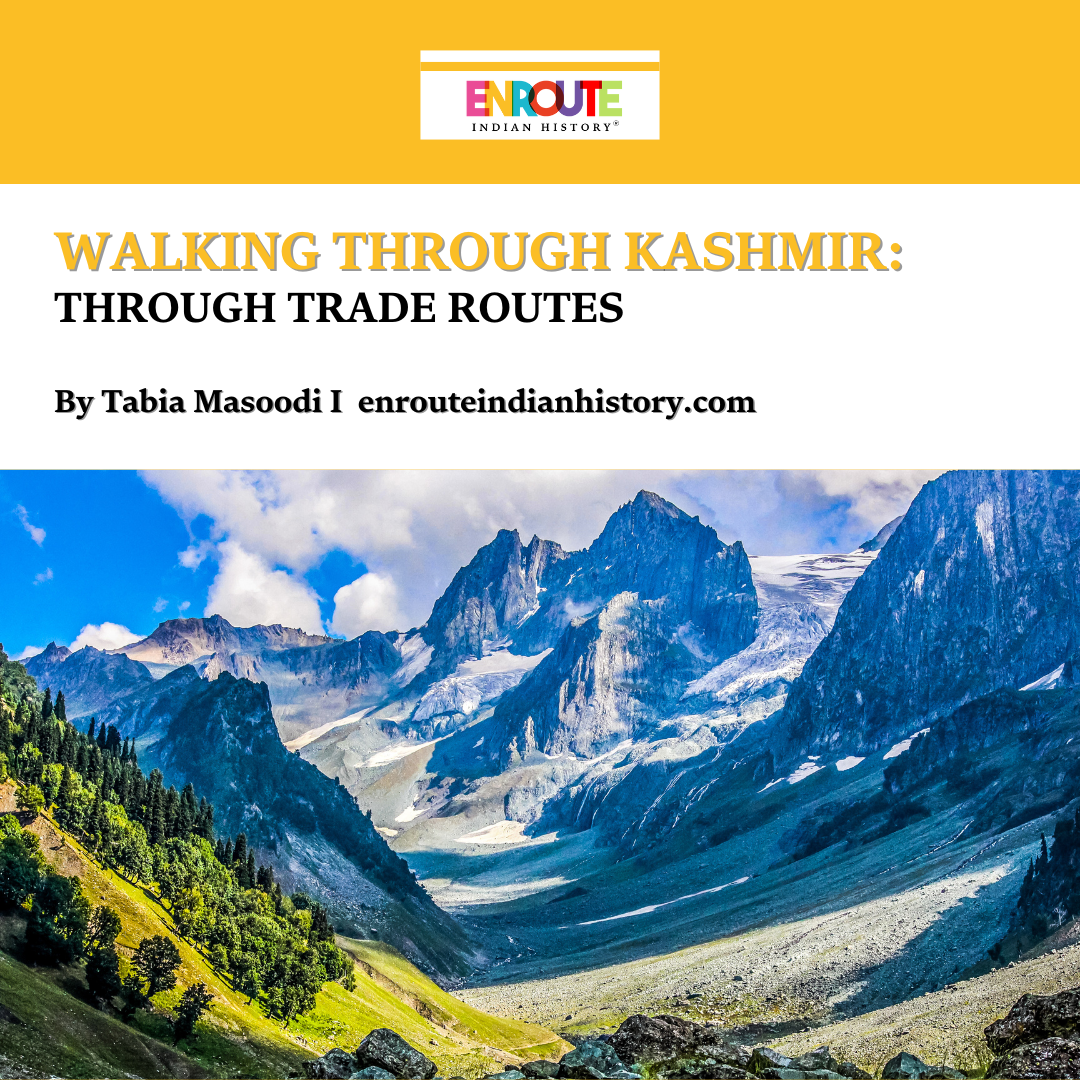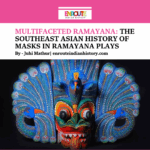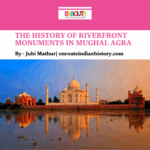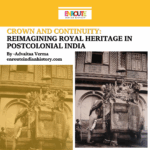
By Tabia Masoodi
The sense of belonging is a virtue shared by all living beings. Connectedness and sharing of culture, exchange of goods, and technology have been essential elements and means of survival for every civilisation. For civilisations to thrive, it is instrumental for them to stay connected and to know each other's traditions, art, music, and food, as well as trade with each other to boost the economy and maintain power. This connectedness can only be established by making different routes through which one can easily exchange norms and values. All the civilizations of their times have established certain routes that are still present even though the civilizations have ended.
Kashmir's historical significance is instrumental, especially during the Mughal period, in terms of its trade routes due to its geographical location and the role that it played. Kashmir was situated at the intersection of major empires and facilitated trade with India, Central Asia, Tibet and China. Kashmir's positioning made it crucial for commerce and cultural exchanges, and it led the Mughals to maintain power and gain access to resources, renowned craftsmanship like carpets and shawls, and trade goods, making Kashmir an economic hub. Recognising the value, the Mughals worked to maintain the routes that resulted in better trade. Another significance of its strategic location is its mountainous terrains; even though
they posed challenges, they also protected against invasions.
TRADE ROUTES OF KASHMIR
Kashmir was a vital stretch of the Silk Road, the most important route between Central Asia and South Asia, which ran through Zojila Pass, connecting locations like Ladakh, Baltistan, and Tibet and cities like Kashghar and Yarkand, promoting commercial and cultural exchanges between East and West. Indian spices were transported to Central Asia, and caravans carried silk, pashmina wool, and dried fruits to Kashmir. Key stations such as Kak
Sarai in Srinagar functioned as waypoints for caravans travelling from Ladakh and Yarkand (Hussain, 2024).
Other major Kashmir trade routes that connected it with the Indian subcontinent held a lot of significance as well, especially during the Mughal period, like the Kashmir-Bhimber route connected to the Indian subcontinent and the Varmul(Baramulla)-Palkhi route, which connected to Peshawar, Hazara and beyond, the Kashmir-Kishtwar route and the Jehlum Valley route among others.
NAVIGATING THE TWO MAJOR ROUTES
Kashmir-Bhimber Route
The road is first mentioned in the writings of Chinese traveller and writer Aokong, who visited Kashmir in 659 CE. Kalhana also mentions it in his Rajtarangni. Before being part of the Mughal legacy, the road was used as a means of transportation for salt from west Punjab to Kashmir, leading to its name as Namak Road or Salt Road.
Akbar commissioned the route's development in the 16th century and strengthened it into an imperial road to connect Kashmir to Mughal regions in the Indian plains, owing to its strategic importance. The road originated from Bhimber, the southwestern part of undivided Kashmir and passed through Adidak (Adi Dat), Jogi Hati, Naushahra, Chingus Hati, Rajouri, Thanamandi, Bahramgala, Poshiana, Pir Ki Gali, Aliabad, Hirpur, and Shupyan(Shopian) before reaching Srinagar in the Kashmir Valley and connected it with Gujarat(lesser Gujrat in Lahore). Bhimber was known as Baab-e-Kashmir(gateway to Kashmir) due to its location as the entry point into the valley for travellers coming from Punjab and other parts of unpartitioned India. The road from Lahore to Bhimber was level, while the route from Bhimber to Kashmir was hilly and winding through rugged mountainous terrain. The travel from Lahore to Bhimber took eleven or twelve days, and from Bhimber to Kashmir took only five days. Carts, wagons, and camels did not travel beyond Bhimber because of the convoluted path and insurmountable challenges of the road, which ran mostly across the
highest peaks. Therefore, everything was carried on the backs of elephants, horses, mules, and porters. This road was tough and remained blocked during the winter months, particularly from December to April (Dar, 2021).
It was the most important trade route during the Mughal period and was heavily used by them. The road flourished during Emperor Jhangir's time. He named it the Mughal Road. Emperor Akhbar and Jhengir built many caravanserais along the Mughal road for travellers, traders, and royal caravans, strategically placing them at regular intervals and providing shelter and food. There were 14 halting stations equipped with caravanserai(Sarai), mosques, bazaars and hamams along the route, including Aliabad Sarai near Shupyan (Shopian), Hipur Sarai, Gujarat (near Lahore), Bhimber, Saidpur, Nowshera, Chingus, Rajouri, Thanamandi, Behramgala, Poshiana, Shadimarg near district Pulwom(Pulwama), Khanpura near district Budgam and Srinagar.
EXTERNAL TRADE VIA KASHMIR-BHIMBER ROUTE
The Kashmir-Bhimber route was a crucial trade route that facilitated the exchange of commerce and commodities along with the exchange of the culture of Kashmir with Indian plains as well. The main goods traded along the route included Kashmiri handicrafts such as Shawls, carpets, silk, paper, papier-mâché items, and carved wooden products. Kashmiri shawls were particularly renowned for their quality and texture. Among agricultural products, Fruits (apples, pears, walnuts), grains, ghee, and oil seeds were significant exports to various markets on the Indian mainland. Kashmir also sent large quantities of fruits and dry fruits to Lahore, Ahmadabad (Gujarat), Agra, and Amritsar. Saffron, the world's most expensive spice, grown in the Pampar(Pampore) area, was also exported (Jan, 2022). Other goods such as Wool and textiles, homespun fabrics and pashmina wool, poppy, raw silk, and timber (e.g., deodar wood) were major exports. Wool for shawls was also imported into Kashmir from Tibet and Yarkhand through this route, along with salt from Punjab, sugar and cotton cloth from Bengal, and Spices such as Cloves, Pepper, Turmeric, Ginger, and Mace Imported from South India and coastal regions(Ahmad, M.,2017).
DECLINE OF KASHMIR-BHIMBER ROAD(MUGHAL ROAD)
With Aurangzeb's death in 1707 CE, the Mughal empire saw deterioration, and so did the road, which saw a drastic decline, hence losing its significance. The last Caravan that travelled on the route was that in the reign of Aurangzeb in 1665. This decline is indicative of the centuries-long interaction between political fragmentation, geographic difficulties, and shifting priorities that led to the negligence of this route
The Afghan rulers who succeeded the Mughals changed their course along the Jhelum basin of northern routes via Uri and Varmul-Pakhil as it was more accessible to reach Peshawar from their capital. Hence leaving the Mughal road neglected and degraded. By the time the Sikh regime came into power, the once-prominent Mughal road was left in shambles and unusable. Additionally, other infrastructure improvements eclipsed the already deteriorated Mughal road after the Dogras took control. Furthermore, maintenance was challenging because of the landslide-prone, steep terrain. Development was also hampered by environmental issues, including wildlife disruptions.
The road's destruction was exacerbated further by India's 1947 partition. The Mughal Road was one of many historic routes that were disturbed by the division of India and the subsequent division of Jammu and Kashmir. In its initial form, this fragmentation made it non-functional. Additionally, there was no way to maintain or re-establish continuity along this route due to Indo-Pak conflicts over Kashmir.
Varmul(Baramulla)-Pakhil Route
Before making the magnificent Mughal Road a preferred route for travel and trade, Emperor Akbar's entry to Kashmir was through the Varmul-Pakhil road. Akbar's army used the Pakhil route to annex Kashmir into the Mughal empire in 1586 under the command of Raja Bhagwan Das and Shah Quli Mehram, Mughal commanders. He entered via Pakhil and passed through Baramulla before advancing to Srinagar. The route connected Kashmir with Punjab, Hazara and Rawalpindi. Varmul was known as the northern gateway to Kashmir. The route was crucial for trade and commerce of Kashmir during the Kashmir Sultanate period as well(1339-1586).
The Indus ferry near Attock served as the route's beginning point. Up to the Kunhar (Nainsukh) River, it travelled via Hasan Abdal, Sultanpur, Sanji, Nawashahr, Dhamtaur, Salhar, Malgalli, Sawadnagar, and Pakhil. The river was bridged at Shangraf Kani, on the Pakhil border, beneath Gadhi Habibullah. It proceeded along the left bank of the Jhelum after crossing the KishanGanga, passing through Wachaha, Baltar, Bolyas [Pellasa], Pim
darang, Bakkar, Musaran, Bhulbas, Kahai, Riwand, Kuwarmat (Kuwarmast), and up to Varmul. There were two ways to travel from Varmul to Srinagar. One route crosses the Jhelum River and passes through Wular Lake, Andrakal, and Paraspur before arriving in Srinagar. The other route passes via Noupora, Pattan, Sopur, and Shihabud-ud-dinpur before arriving in Srinagar (Dar, 2021).
The route played an important part in trade and travel before the partition of India, connecting the valley with the Indian subcontinent. Though the road has typical features of Himalayan geography with steep ascents, narrow passes and curves, it remained open throughout the year as it received lesser snowfall compared to other trade routes that were rendered inaccessible due to harsh winter. The ponies, pack horses, elephants, and even heavy armour were carried on this route.
The route, however accessible throughout the year, was comparatively longer, and after the annexation of Kashmir by the Mughals, the route remained inactive between 1586 and 1700 as they preferred to traverse by a shorter route via the Namak route or Mughal imperial road, leading to the negligence of the Varmul-Pakhil road. By the time Afghan rulers invaded Kashmir, they revived the route as it was more accessible for them to reach Kabul and Peshawar from Kashmir. Later, Sikhs and Dogra rulers also kept the road alive.
TRADE VIA Varmul-PAKHIL ROUTE
DURING SULTANATE PERIOD
During the Sultanate period, a custom house at Varmul was established to regulate trade. Custom duties were levied on cotton, and merchants were required to carry passports to traverse along this route. Kashmir exported saffron, shawls, apples, walnuts, and other fruits, as well Kashmir Timber from Kashmir's forests, and handmade paper were key exports. While importing essential commodities like salt and cotton from Punjab, and spices and sugar from Indian markets. During the Sultanate, the route was not much developed with advanced infrastructure, and roads were narrow, hence unsuitable for large caravans. The travel relied on river transport along the Jhelum River for the most part. As a result, trade was limited, and Lighter goods were traded along this route.
DURING MUGHAL PERIOD
While the goods traded were largely similar, there were noteworthy differences in terms of scale, infrastructure, and trade priorities. The Mughals focused more on luxury goods like Kashmiri shawls, saffron and carpets. Likewise, woolen goods also continued at a larger scale due to demand across the empire, while imported goods remained largely the same. Mughals also improved the infrastructure along the route and built caravanserai. However, the route's significance was diminished after Mughals traversed via a shorter route, i.e., the Mughal road.
DECLINE OF VARMUL-PAKHIL ROUTE
The road saw an array of ebb and flow throughout different powers occupying Kashmir; however, after the Dogra period, the road was in its final phases. The Varmul-Pakhil route saw its decline for many reasons, including partition, construction of new infrastructures, and political instability, among others. By the 19th century, the then-prevailing British rule provided modern motorable alternative roads for a better and more efficient travelling experience. Jhelum Valley Cart Road, which connected Srinagar to Rawalpindi via Varmul and Uri, proved to be a more reliable route as compared to the older Varmul-Pakhil route. Moreover, areas such as Hazara falling under the Varmul-Pakhil route were marred with violence and experienced political instability during the Afghan- Sikh wars, leaving the route less secure for trade and travel. The tribal invasion of October 1947 caused widespread destruction in Varmul and severely impacted its infrastructure, significantly affecting the route. Post-partition of India, with the establishment of new borders, the Varmul-Pakhil route was divided, disrupting the connectivity and losing its strategic importance. Additionally,
with the advent of new transportation, other routes like the Banihal Cart Road and Mughal Road gained prominence, leaving this route, without maintenance, less visible compared to other new routes.
As both routes are not operational in their historical perspective as trade routes, the Mughal road is functional as a road connecting Shupyan in Kashmir to Rajouri and Poonch in Jammu, as well as serving as an alternative route for goods transport. It is kept well alive by Bakerwals(shepherds) who migrate from the upper reaches to Srinagar via the Mughal road. The Varmul-Pakhil road has completely lost its traditional importance, and currently, there is no active trade or transport along the route.
References
Dar, Zahid Ahmad. "TRADE ROUTES IN MUGHAL KASHMIR: A HISTORICAL STUDY." International Journal Of Creative Research Thought, vol. 9, no. 1 January 2021, 2021, p. 7. TRADE ROUTES IN MUGHAL KASHMIR: A HISTORICAL STUDY, TRADE ROUTES IN MUGHAL KASHMIR: A HISTORICAL STUDY.
Hussain, Hayat. "The Silk Road's Hidden Gem: Kashmir's Enduring Cultural and Historical Ties With Central Asia." The Diplomat, 14 December 2024,
https://thediplomat.com/2024/12/the-silk-roads-hidden-gem-kashmirs-enduring-cultural-and-historical-ties-with-central-asia/. Accessed 8 March 2025.
Jan, Dr. Shoki. "Sarias In Kashmir Under The Mughals." International Journal of Creative Research Thought, vol. 12, no. 1 January 2024, 2024, p. 4. IJCRT.ORG,
https://ijcrt.org/papers/IJCRT2401688.pdf.
Jan, Shoki Jan. "Inland and external trade in Kashmir during the Mughal period (1586-1752)." International Journal of Creative Research Thought, vol. 10, no. 12 December 2022, 2022, p. 5. IJCRT.ORG, https://ijcrt.org/papers/IJCRT2212317.pdf.
Wani, Shakeela. "THE TRADE ROUTES OF MUGHAL KASHMIR: A GATEWAY TO PROSPERITY AND CULTURAL EXCHANGE." Gadyal Kashmir, 09 10 2024,
https://gadyalkashmir.com/2024/10/09/the-trade-routes-of-mughal-kashmir-a-gateway-to-prosperity-and-culturalexchange/#:~:text=One%20of%20the%20most%20important,Sopur%2C%20before%20reaching%20the%20valley.
Ahmad, M. (2017) 'Mughals and Kashmir with its economy (1586-1752 AD)', IOSR Journal of Humanities and Social Science (IOSR-JHSS), 22(2), pp. 59–68. doi:10.9790/0837- 2202055968.
Dutta, P. (n.d.) The Mughal Imperial Road: Jammu and Kashmir section. Sahapedia.
Available at: https://www.sahapedia.org/the-culture-of-travel-the-mughal-imperial-road



















